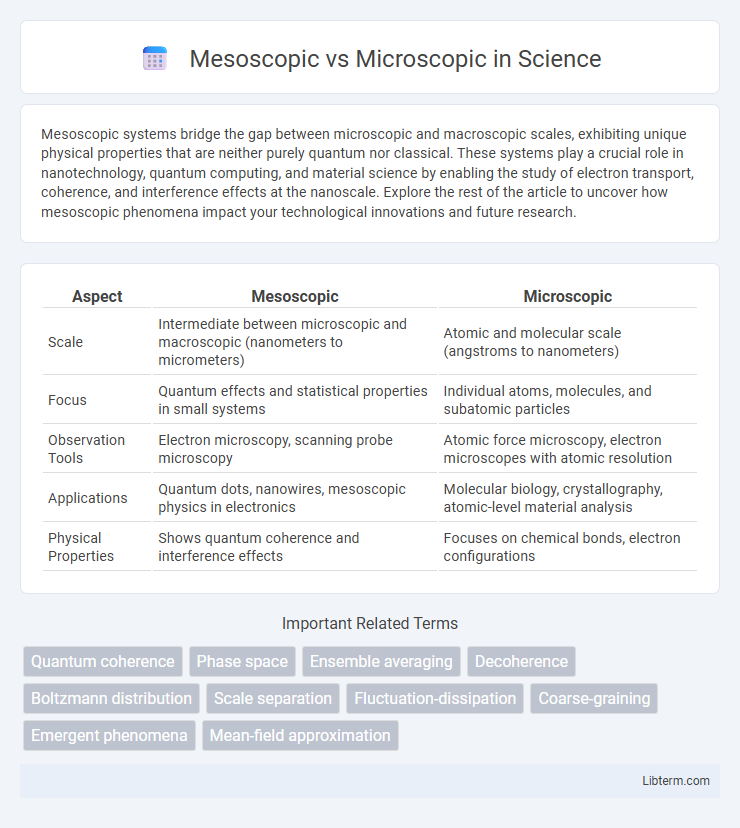Mesoscopic systems bridge the gap between microscopic and macroscopic scales, exhibiting unique physical properties that are neither purely quantum nor classical. These systems play a crucial role in nanotechnology, quantum computing, and material science by enabling the study of electron transport, coherence, and interference effects at the nanoscale. Explore the rest of the article to uncover how mesoscopic phenomena impact your technological innovations and future research.
Table of Comparison
| Aspect | Mesoscopic | Microscopic |
|---|---|---|
| Scale | Intermediate between microscopic and macroscopic (nanometers to micrometers) | Atomic and molecular scale (angstroms to nanometers) |
| Focus | Quantum effects and statistical properties in small systems | Individual atoms, molecules, and subatomic particles |
| Observation Tools | Electron microscopy, scanning probe microscopy | Atomic force microscopy, electron microscopes with atomic resolution |
| Applications | Quantum dots, nanowires, mesoscopic physics in electronics | Molecular biology, crystallography, atomic-level material analysis |
| Physical Properties | Shows quantum coherence and interference effects | Focuses on chemical bonds, electron configurations |
Introduction to Mesoscopic and Microscopic Scales
Mesoscopic and microscopic scales refer to different levels of observation in scientific analysis, where microscopic scale examines structures at the cellular or molecular level typically ranging from nanometers to micrometers. Mesoscopic scale bridges the gap between microscopic and macroscopic scales, often dealing with systems sized between hundreds of nanometers to a few micrometers, capturing collective behaviors that individual microscopic components exhibit. Understanding these scales is crucial in fields such as material science, biophysics, and nanotechnology for analyzing phenomena that are not apparent at larger or smaller scales.
Defining Mesoscopic Systems
Mesoscopic systems refer to structures sized between microscopic and macroscopic scales, typically ranging from nanometers to micrometers, where quantum mechanical effects dominate electron transport. These systems exhibit unique behaviors such as quantum interference, conductance quantization, and phase coherence, distinguishing them from purely microscopic atomic or molecular systems. Understanding mesoscopic phenomena is crucial for the development of nanoelectronics and quantum computing technologies.
Understanding Microscopic Systems
Microscopic systems refer to structures and phenomena occurring at the atomic or molecular scale, typically below 100 nanometers, where quantum effects dominate and precise particle interactions govern behavior. Understanding microscopic systems requires analyzing quantum states, electron configurations, and molecular dynamics using advanced techniques like scanning tunneling microscopy and quantum simulations. This knowledge is crucial for developing nanotechnology applications, quantum computing, and materials science innovations.
Key Differences Between Mesoscopic and Microscopic
Mesoscopic systems describe structures larger than atomic scale but smaller than macroscopic objects, typically in the range of nanometers to micrometers, capturing quantum coherence and electronic transport phenomena not visible in microscopic models. Microscopic analysis focuses on atomic and molecular levels, detailing individual particles and their interactions, essential for understanding fundamental chemical and physical properties. Key differences include the scale of observation, with mesoscopic bridging the gap between quantum behavior and bulk properties, and the prominence of quantum interference effects in mesoscopic systems absent in completely microscopic frameworks.
Physical Phenomena at the Mesoscopic Scale
Physical phenomena at the mesoscopic scale bridge quantum and classical behaviors, revealing unique electronic, optical, and thermal properties not observable at microscopic or macroscopic levels. Quantum coherence and interference effects dominate, leading to phenomena such as conductance quantization and electron tunneling in mesoscopic systems. These effects play a critical role in nanotechnology, quantum computing, and materials science by enabling control over electron transport and wavefunction coherence in mesoscopic devices.
Observation Techniques: Mesoscopic vs Microscopic
Mesoscopic observation techniques bridge the gap between macroscopic and microscopic scales, utilizing methods like electron microscopy and X-ray tomography to analyze structures from tens to hundreds of nanometers. Microscopic techniques, such as light microscopy and atomic force microscopy, provide detailed visualization at the cellular or molecular level, often below 100 nanometers. The choice between mesoscopic and microscopic methods depends on the required resolution and the specific application in materials science or biological research.
Quantum Effects in Mesoscopic Systems
Quantum effects in mesoscopic systems emerge prominently when the system size approaches the electron coherence length, enabling phenomena like quantum interference and conductance quantization, which are absent in microscopic regimes. Unlike microscopic systems where atomic-scale interactions dominate, mesoscopic systems exhibit phase coherence over larger distances, allowing observation of effects such as weak localization and universal conductance fluctuations. These quantum behaviors are critical for developing quantum devices and understanding electronic transport in nanoscale materials.
Applications of Mesoscopic and Microscopic Analysis
Mesoscopic analysis is widely applied in material science to study the behavior of composites and porous media at scales where microstructural features influence overall properties, enabling accurate predictions of mechanical performance and fluid flow. Microscopic analysis focuses on examining materials at the cellular or atomic level, crucial for fields like nanotechnology, semiconductors, and biological sciences, where understanding interactions at the smallest scale drives innovation. Both approaches complement each other by bridging different scale-dependent phenomena, enhancing design precision in engineering and biomedical applications.
Challenges in Mesoscopic vs Microscopic Research
Mesoscopic research faces challenges in accurately bridging the gap between atomic-scale phenomena and macroscopic properties, often requiring sophisticated multiscale models to capture intermediate behaviors. Microscopic research struggles with limitations in spatial and temporal resolution when observing individual atoms or molecules, demanding advanced imaging techniques like electron microscopy and atomic force microscopy. Both scales involve complex computational demands, yet mesoscopic studies must address emergent properties that do not manifest at smaller scales, complicating theoretical and experimental approaches.
Future Trends in Scale-Based Scientific Studies
Future trends in scale-based scientific studies emphasize integrating mesoscopic and microscopic approaches to bridge the gap between atomic-level interactions and larger-scale phenomena. Advances in high-resolution imaging, machine learning algorithms, and multi-scale modeling enable more precise simulations and predictions of complex systems ranging from biological cells to novel materials. This convergence accelerates innovations in nanotechnology, personalized medicine, and quantum computing by providing detailed insights across diverse length scales.
Mesoscopic Infographic

 libterm.com
libterm.com